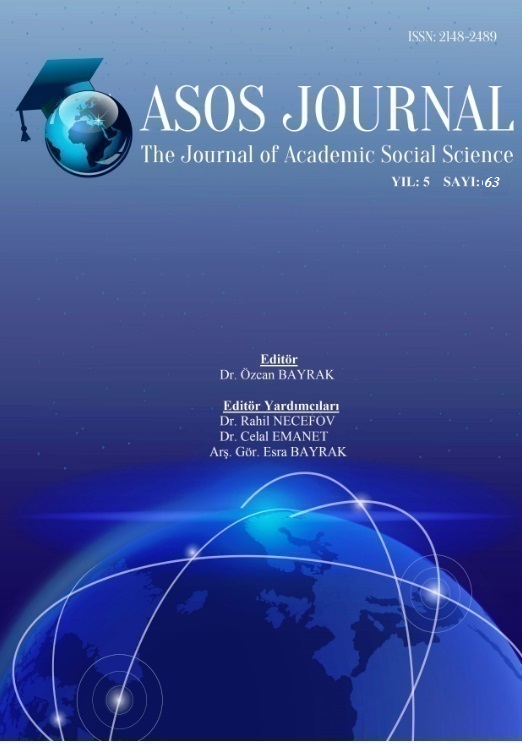SOVYET KARŞITLIĞI İLE ALMAN SEMPATİSİ ARASINDA AZERBAYCAN MİLLİYETÇİLİĞİNİN BİR TEMSİLCİSİ OLARAK KURTULUŞ DERGİSİ (1934-1939)
Author :
Abstract
1917 Ekim Devrimi ardından bağımsızlığını ilan eden Azerbaycan, 1920’de Bolşeviklerin denetimi ele geçirmesiyle, bağımsızlığını yitirmiş, milliyetçilerin bağımsızlık mücadelesi ise ülke dışına yayılarak, çeşitli araçlarla devam etmiştir. “Azerbaycan Milli Kurtuluş Hareketi”nin yayın organı olarak Berlin’de yayınlanan Kurtuluş dergisi, 1930’lu yıllarda, bu mücadelenin dışarıya yansıyan sesi olarak dikkat çekmiştir. Kurtuluş’un yayınlandığı 1934-1939 dönemi İkinci Dünya Savaşına gidiş sürecine denk gelmiş olup, dergi pozisyonunu savaş öncesi politikalar çerçevesinde şekillendirmiştir. Başta Nazi Almanyası olmak üzere revizyonist devletlerin, Birinci Dünya Savaşı sonrası kurulan dengeleri değiştirmeye dönük taleplerle ortaya çıktığı, dünyadaki güç mücadelesinin keskinleştiği bir dönemde, anti-komünist, anti-Sovyet çizgiyi esas alan Kurtuluş, Almanya’nın başını çektiği revizyonist cephenin yanında durmuştur. Sovyetler Birliği ve komünizm sürekli düşman konumuyla öne çıkarılmıştır. Revizyonist cephe, Sovyetleri geriletecek ve bağımsızlık için fırsatlar sunacak bir güç olarak görülmüş, desteklenmiştir. Çalışmanın çerçevesini, Kurtuluş dergisinin 1934-1939 döneminde yayınlanmış 54 sayısı oluşturmuştur. Çalışmanın amacı doğrultusunda, II. Dünya Savaşı’na gidiş süreci bağlamında, Kurtuluş’un dünya politikasına dair duruşu üzerinde durulmuş, elde edilen veriler bağlamında, Sovyetler Birliği ve Almanya’ya bakışı değerlendirilmiştir. Böylece bağımsızlık peşindeki Azerbaycanlı milliyetçilerin, İkinci Dünya Savaşı öncesi dönemde Sovyetler Birliği karşısında, Almanya’ya yakın durmalarının nedenleri, “Rusya mahkumu milletler”in destekçisi sıfatıyla Almanya’ya biçtikleri misyon sorgulanmış, değerlendirilmiştir.
Keywords
Abstract
Azarbaijan which declared its independence after the 1917 October Revolution, lost its independence after the Bolsheviks seized control in 1920s, and the independence struggle of the nationalists spread abroad continuing by various means. The Kurtuluş magazine which was published as the organ of the “Azarbaijan National Liberation Movement” drew attention as the voice of the movement outside the country in 1930s. The 1934-1939 period when Kuruluş was published coincided with the period leading to the WW II and the magazine formed its position according to the pre-war policies. In a period when the revionist states and Nazi Germany foremost appeared by demands to change the balance of power established after the WW I, and when the power struggle in the world got sharpened, Kurtuluş which was grounded on the anti-communist and anti-Soviet stance sided by the revisionist front led by Germany. The Soviet Union and communism were continuously put forward as an ‘enemy’. The revisionist front was seen as a power that could backspace the Soviets and create opportunities for independence. The framework of our study is constituted by the 54 issues of the magazine published during the 1934-1939 period. In accordance with the study’s goal and within the context of the process leading to the WW II , the Kurtuluş’s stance on the world politics is elaborated and their views on Soviet Union and Germany is evaluated within the context of the data obtained. In this way, the reasons as to why Azarbaijani nationalists stood closer to Germany against the Soviet Union during the WW II and the mission they ascribed to Germany as the supporter of the nations “imprisoned by Russia”, are questioned and evaluated.
